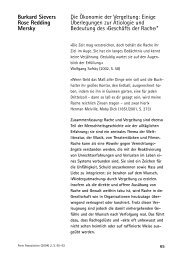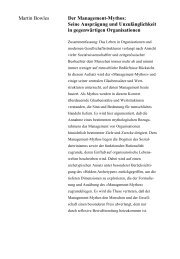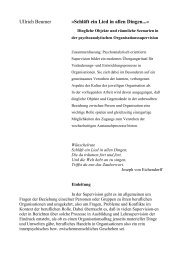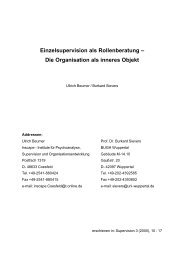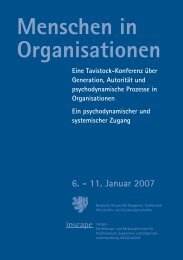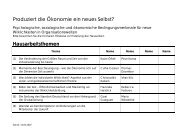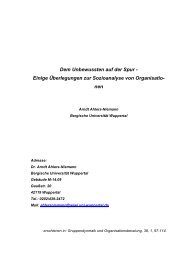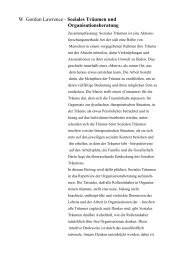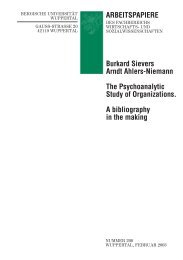Curing the monster Some images of and considerations - Prof. Dr ...
Curing the monster Some images of and considerations - Prof. Dr ...
Curing the monster Some images of and considerations - Prof. Dr ...
You also want an ePaper? Increase the reach of your titles
YUMPU automatically turns print PDFs into web optimized ePapers that Google loves.
- 8 -<br />
relatively clear origin but also a significant relevance as a symbol <strong>of</strong> many<br />
European nations. As he was <strong>the</strong> patron saint <strong>of</strong> all those who had devoted <strong>the</strong>ir<br />
lives to fighting, St. George was also <strong>the</strong> patron <strong>of</strong> <strong>the</strong> crusaders. They obviously<br />
were <strong>the</strong> ones who brought <strong>the</strong> image <strong>of</strong> St. George as <strong>the</strong> dragon fighter back. It<br />
<strong>the</strong>n ultimately became a constituent part <strong>of</strong> his iconography through Jacobus de<br />
Voragine a dominican <strong>and</strong> archbishop <strong>of</strong> Genua, who, in <strong>the</strong> 13. century, included<br />
this legend into his 'Legenda Aurea' (Golden Legend) which was <strong>of</strong> great influence<br />
on folkloristic piety (Braunfels-Esche 1976: 21 ff.; Egli 1982: 223 ff.). Although<br />
St.George did not <strong>of</strong>ficially become <strong>the</strong> national patron <strong>of</strong> Engl<strong>and</strong> until 1347, his<br />
feast, <strong>the</strong> 23rd <strong>of</strong> April, received <strong>the</strong> same rank as <strong>the</strong> great feasts <strong>of</strong> <strong>the</strong><br />
ecclesiastical year through a synod at Oxford in 1222. Around that time he also<br />
became <strong>the</strong> national patron <strong>of</strong> Georgia, Greece, Russia, Hungary, Pol<strong>and</strong> <strong>and</strong><br />
Sweden; in Germany he was <strong>the</strong> patron <strong>of</strong> <strong>the</strong> nobility.<br />
Figure 3: Albreht Dürer, St. George killing <strong>the</strong> dragon. Woodcot ca. 1501/04<br />
That <strong>the</strong> dragon became <strong>the</strong> incarnation <strong>of</strong> evil, <strong>the</strong> enemy <strong>and</strong> <strong>of</strong>ten enough <strong>the</strong><br />
devil in Christian mythology during <strong>the</strong> last millenium not only became evident<br />
through thous<strong>and</strong>s <strong>of</strong> churches which were dedicated to St. George all over<br />
Europe but also through <strong>the</strong> fact that <strong>the</strong> legends <strong>of</strong> nearly 60 saints are based,<br />
one way or <strong>the</strong> o<strong>the</strong>r, on dragon killing (Aufhauser 1911: 239); among <strong>the</strong>m are<br />
also women who like St. Martha vanquished <strong>the</strong> dragon with holy water or St.<br />
Margaretha who became <strong>the</strong> patron <strong>of</strong> pregnant women, because, when she was<br />
swallowed by <strong>the</strong> dragon, <strong>the</strong> cross which she was wearing grew till it finally burst<br />
<strong>the</strong> <strong>monster</strong> (Redaktion ... 1985: 95; cf. Roheim 1972: 299).<br />
That <strong>the</strong> dragon also has a long tradition in our western military history is, for<br />
example, indicated by <strong>the</strong> 'dragons', <strong>the</strong> French cavalrymen in <strong>the</strong> Thirty Years<br />
War, who were equipped with small-arms called 'fire-spitting dragons'; it seems<br />
that <strong>the</strong> fact that, for example, <strong>the</strong> English, French, German, <strong>and</strong> <strong>the</strong> Swedish<br />
language have incorporated <strong>the</strong> Latin 'draco' (which was taken from <strong>the</strong> Greek<br />
'drakon'), originates from <strong>the</strong> dragon as a cohort sign <strong>of</strong> <strong>the</strong> Romans which <strong>the</strong>y<br />
<strong>the</strong>mselves had adopted from <strong>the</strong>ir Teutonic enemies (Höfler 1961: 99). The selfidentification<br />
with <strong>the</strong> dragon in order to put one's enemies to flight is in itself a



